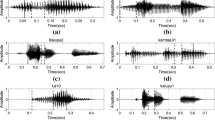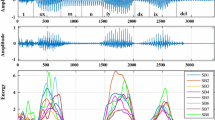Abstract
Phonetic feature extraction is used in many types of speech applications. In this paper, we propose an approach for automatic detection of retroflex approximant
 in a Tamil continuous speech using sonorant regions and formant structure of speech. Retroflex approximant is one of the distinctive phonetic features of Tamil speech. It occurs in V_V and V_ contexts. In the proposed approach, slopes of the formant trajectories and spectral dynamics of F2 and F3 in the region of retroflex approximant are considered as acoustic cues for detecting them in continuous speech. In this work, numerator of the group delay function-based formant extraction method is used to track formant trajectories. Based on experimental results, formants extracted using this approach produced better evidence compared to state-of-the-art formant extraction techniques for retroflex approximant detection.
in a Tamil continuous speech using sonorant regions and formant structure of speech. Retroflex approximant is one of the distinctive phonetic features of Tamil speech. It occurs in V_V and V_ contexts. In the proposed approach, slopes of the formant trajectories and spectral dynamics of F2 and F3 in the region of retroflex approximant are considered as acoustic cues for detecting them in continuous speech. In this work, numerator of the group delay function-based formant extraction method is used to track formant trajectories. Based on experimental results, formants extracted using this approach produced better evidence compared to state-of-the-art formant extraction techniques for retroflex approximant detection.





Similar content being viewed by others
References
A.M.A. Ali, J. Van der Spiegel, P. Mueller, Acoustic-phonetic features for the automatic recognition of stop consonants. J. Acoust. Soc. Am. 103(5), 2777–2778 (1998)
A.M.A. Ali, J. Van der Spiegel, P. Mueller, An acoustic-phonetic feature-based system for the automatic recognition of fricative consonants, in Proceedings of the 1998 IEEE International Conference on Acoustics, Speech and Signal Processing, ICASSP 1998, Seattle, WA , USA, vol. 2, pp. 961–964, (1998)
J.M. Anand, S. Guruprasad, B. Yegnanarayana, Extracting formants from short segments of speech using group delay functions, in Proceedings of INTERSPEECH, (2006)
M.S. Andronov, The Tamil language. Nauka (1965)
P.C. Delattre, A.M. Liberman, F.S. Cooper, Acoustic loci and transitional cues for consonants. J. Acoust. Soc. Am. 27(4), 769–773 (1995)
S. Edward, Flemming, Auditory Representations in Phonology (Routledge, Abingdon, 2013)
J. Harrington, Phonetic Analysis of Speech Corpora (John Wiley & Sons, Hoboken, 2010)
J.B. Johannessen, B. Vaux, Retroflex variation and methodological issues: a reply to Simonsen, Moen, and Cowen. J Phon. 41(1), 48–55 (2013)
K. Johnson, Acoustic and auditory phonetics. Phonetica 61(1), 56–58 (2004)
I. Kameny, Comparison of the formant spaces of retroflexed and nonretroflexed vowels. IEEE Trans. Acoust. Speech Signal Process. 23(1), 38–49 (1975)
A. Kochetov, N. Sreedevi, M. Kasim, R. Manjula, Spatial and dynamic aspects of retroflex production: an ultrasound and EMA study of Kannada geminate stops. J. Phonet. 46, 168–184 (2014)
P. Ladefoged, P. Bhaskararao, Non-quantal aspects of consonant production-a study of retroflex consonants. J. Phonet. 11(3), 291–302 (1983)
J. Makhoul, Linear prediction: a tutorial review. Proc. IEEE 63(4), 561–580 (1975)
H.A. Murthy, B. Yegnanarayana, Formant extraction from group delay function. Speech Commun. 10(3), 209–221 (1991)
K.S.R. Murty, B. Yegnanarayana, Epoch extraction from speech signals. IEEE Trans. Audio Speech Lang. Process. 16(8), 1602–1613 (2008)
K. Mustafa, I.C. Bruce, Robust formant tracking for continuous speech with speaker variability. IEEE Trans. Audio Speech Lang. Process. 14(2), 435–444 (2006)
S. Narayanan, D. Byrd, A. Kaun, Geometry, kinematics, and acoustics of Tamil liquid consonants. J. Acoust. Soc. Am. 106(4), 1993–2007 (1999)
L .R. Rabiner, R .W. Schafer, Digital processing of speech signals, vol. 30 (Prentice Hall, Upper Saddle River, 1978)
S. Rajaram, Tamil Phonetic Reader, vol. 03, Central institute of Indian languages, (1972)
A. Rao, R. Kumaresan, On decomposing speech into modulated components. IEEE Trans. Audio Speech Lang. Process. 8(3), 240–254 (2000)
C. Smith, M.I. Proctor, K. Iskarous, L. Goldstein, S. Narayanan, Stable articulatory tasks and their variable formation: Tamil retroflex consonants., in: Proceedings of INTERSPEECH, pp. 2006–2009 (2013)
R.C. Snell, F. Milinazzo, Formant location from LPC analysis data. IEEE Trans. Speech Audio Process. 1(2), 129–134 (1993)
K .N. Stevens, Acoustic Phonetics, vol. 30 (MIT press, Cambridge, 2000)
B.H. Story, K. Bunton, Relation of vocal tract shape, formant transitions, and stop consonant identification. J. Speech Lang. Hear. Res. 53(6), 1514–1528 (2010)
A.K. Vuppala, K.S. Rao, Vowel onset point detection for noisy speech using spectral energy at formant frequencies. Int. J. Speech Technol. 16(2), 229–235 (2013)
H.K. Vydana, K.V. Mounika, A.K. Vuppala, Improved syllable nuclei detection using formant energy in glottal closure regions, in: International Conference on Devices, Circuits and Communications (ICDCCom), IEEE, pp. 1–6, (2014)
Acknowledgements
The authors thank Prof. Peri Bhaskararao and S. Rajendran, IIIT Hyderabad, for providing insights of retroflex approximants in Tamil language. We also like to thank Dr. Suryakanth V Gangashetty for his suggestions and partly funding our work through CESP.
Author information
Authors and Affiliations
Corresponding author
Rights and permissions
About this article
Cite this article
Thirumuru, R., Vuppala, A.K. Automatic Detection of Retroflex Approximants in a Continuous Tamil Speech. Circuits Syst Signal Process 37, 2837–2851 (2018). https://doi.org/10.1007/s00034-017-0689-0
Received:
Revised:
Accepted:
Published:
Issue Date:
DOI: https://doi.org/10.1007/s00034-017-0689-0




